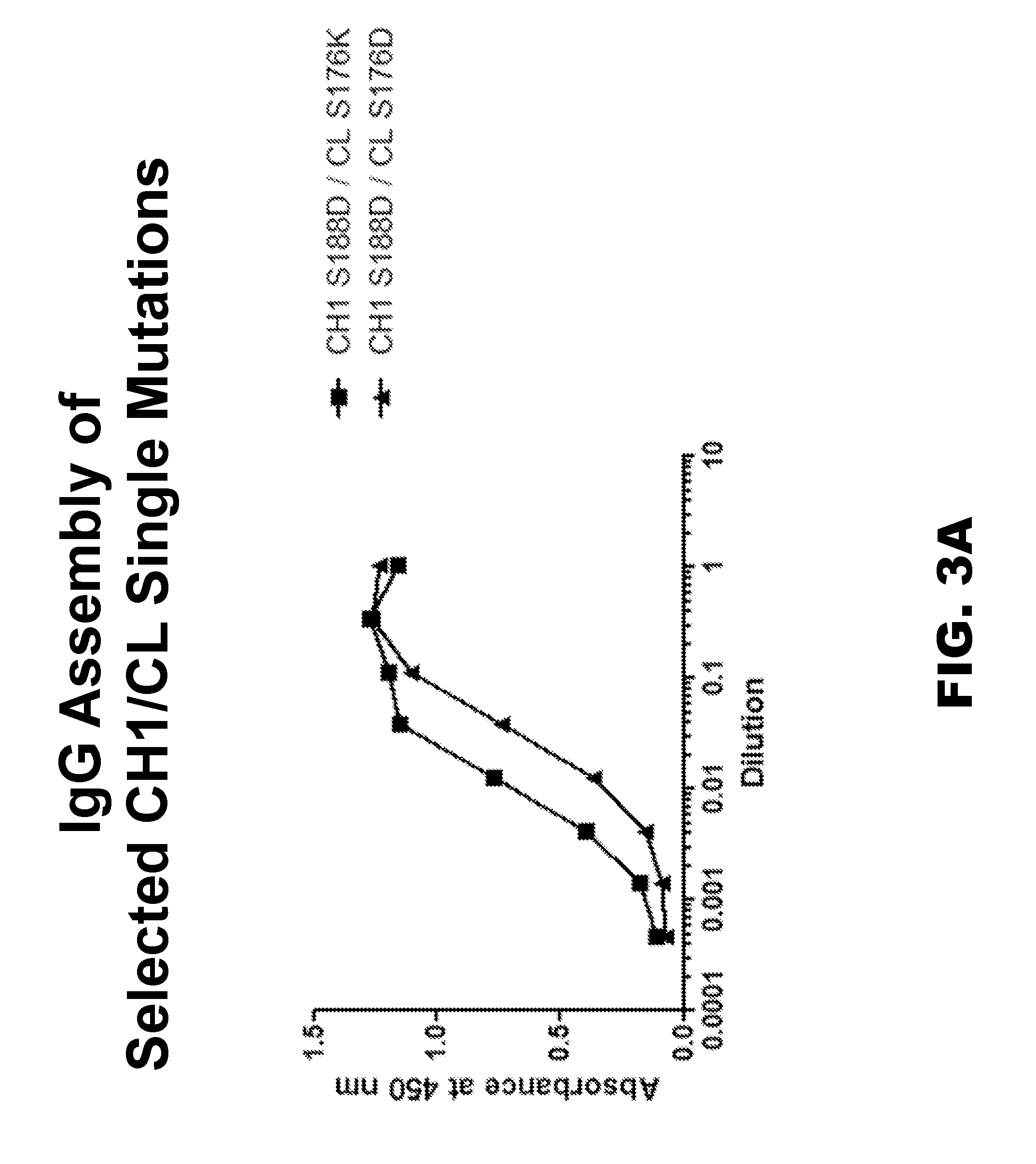Novel multispecific constructs
- Summary
- Abstract
- Description
- Claims
- Application Information
AI Technical Summary
Benefits of technology
Problems solved by technology
Method used
Image
Examples
example 1
Design of Constructs for Heavy Chain / Light Chain Pairing
[0118]Crystal structures of IgGs and Fab fragments were studied to identify candidate sites for residue substitutions to create specificity in pairing between two different heavy chains and two different light chains. Initial analysis was performed on the Protein Data Bank (PDB) model ID 2XRA, with confirmation of candidate site pairs on PDB model ID 3DVN. Candidate sets of residues were chosen on the CH1 and CL domains and are summarized in Table 2 and shown in FIG. 2. Residue numbering follows the Kabat numbering scheme, and one-letter amino acid abbreviations are used. H172 on CH1 was found to be in close proximity to two residues on the CL domain, S174 and N138, so both sites were chosen for residue substitutions. Additionally, H172 on CH1 could also potentially interact with N137 on CL.
[0119]Note that this analysis and subsequent multispecific constructs employ a kappa light chain for the purposes of demonstrating the conc...
example 2
[0121]Evaluation of Candidate CH1 / CL Mutations
[0122]The exemplary bispecific antibody contained two different light chains and two different heavy chains with modifications in the Fc region for asymmetric heavy chain pairing. However, in order to simplify the screening of candidate CH1 and CL mutations, only one heavy chain and one light chain were tested at a time for assembly into a full IgG, without asymmetric heavy chain pairing. Candidate heavy and light chain constructs were cloned into pEE6.4HuIgG1 and pEE12.4Hu-kappa expression vectors (both from Lonza AG) with unmodified Fc regions. Plasmids containing heavy and light chains with candidate CH1 and CL mutations were co-transfected in HEK-293T cells using 293Fectin as a transfection reagent (Novagen). For each CH1 candidate mutation, co-transfections were performed in separate reactions using light chains containing mutations of both opposite and same charge at the corresponding CL site. For example the T192K heavy chain cons...
example 3
Generation of Bispecific Antibodies
[0127]The utility of the sites identified in Example 2 was evaluated in an IgG-like bispecific format such as the one shown in FIG. 1. Bispecific antibodies were constructed using variable regions from the anti-CD324 antibody hSC10.17 (see U.S.P.N. 2013 / 0058947), and Ha22-2(2,4)6.1, which binds Nectin-4 (termed “anti-Nectin-4 antibody”; see U.S.P.N. 2012 / 0078028). The final bispecific antibody was termed anti-CD324 / N4 antibody. Knob into holes (“KiH”) with stabilizing disulfides were used for asymmetric heavy chain pairing (Merchant et al., supra). Knob into holes residue mutation numbering follows the EU numbering scheme. Selected CH1 and CL mutations from Example 2 were used in the CH1 and CL domains. All mutations were incorporated using the Quikchange Mutagenesis kit according to the manufacturer's instructions (Agilent). These mutations are summarized in Table 3. The first construct is an anti-CD324 / N4 bispecific construct having a knob in hol...
PUM
| Property | Measurement | Unit |
|---|---|---|
| Electric charge | aaaaa | aaaaa |
| Cytotoxicity | aaaaa | aaaaa |
| Distribution | aaaaa | aaaaa |
Abstract
Description
Claims
Application Information
 Login to View More
Login to View More - R&D
- Intellectual Property
- Life Sciences
- Materials
- Tech Scout
- Unparalleled Data Quality
- Higher Quality Content
- 60% Fewer Hallucinations
Browse by: Latest US Patents, China's latest patents, Technical Efficacy Thesaurus, Application Domain, Technology Topic, Popular Technical Reports.
© 2025 PatSnap. All rights reserved.Legal|Privacy policy|Modern Slavery Act Transparency Statement|Sitemap|About US| Contact US: help@patsnap.com



